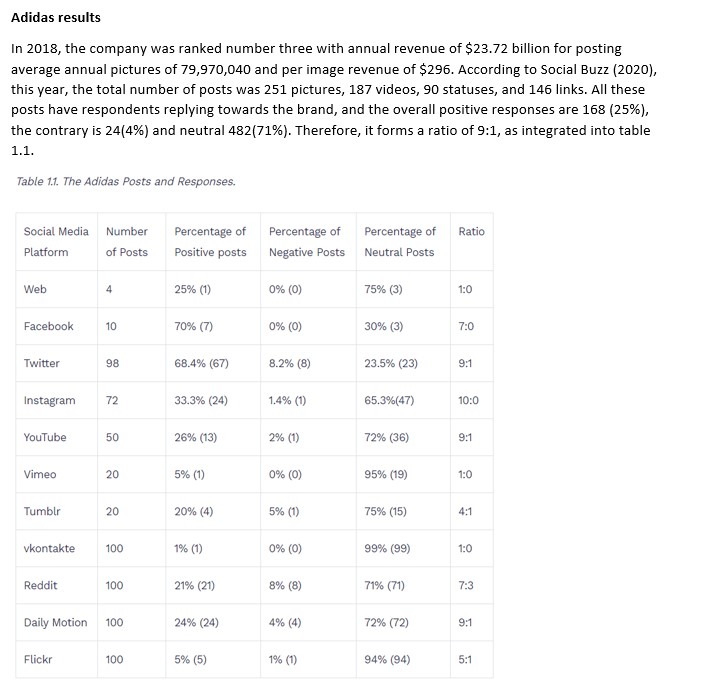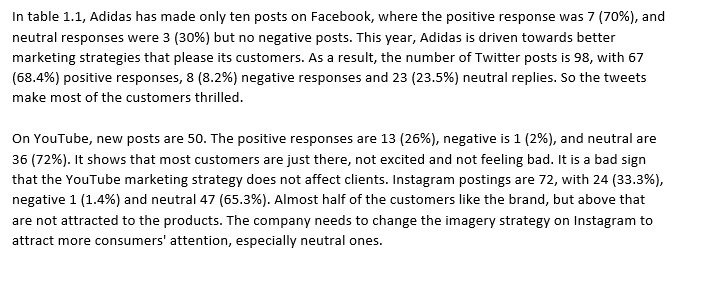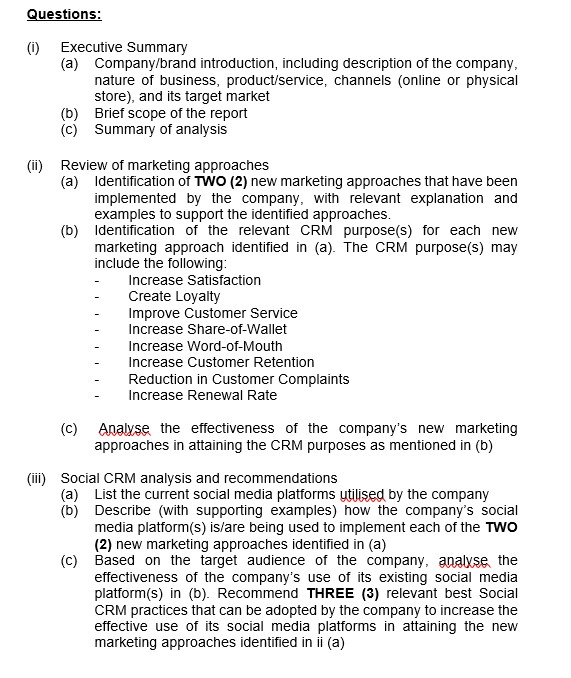Answered step by step
Verified Expert Solution
Question
1 Approved Answer
Case Study-Adidas Brand Company Introduction Adidas is operating and competing in Apparel and accessories industry. The company provides sports shoes and sports clothing materials.




Case Study-Adidas Brand Company Introduction Adidas is operating and competing in Apparel and accessories industry. The company provides sports shoes and sports clothing materials. It is why Adidas's main competitors include Nike, Puma and many others in the Apparel industry. One of the most profitable industries in the world is the sports industry. The Adidas brand's products and competitiveness are helping the company to remain relevant in the market. Adidas's approach is to ensure that its products compete well against the competitors in the market (Aitman, 2015). The various products also offer a range of products that maintains the brand's relevance to the various clients in the market (Aitman, 2015). Adidas wins people's hearts on social media. 1. Create a compelling tagline - "Impossible is Nothing." 2. Build intelligent social media campaigns 3. Advocate for sustainability 4. Stand for a social cause 5. Partner with influencers 6. Inspire and empower women 7. Adidas' social media data performance Adidas uses social media to drive sales. Facebook Instagram Twitter Pinterest Tik Tok You tube Adidas results In 2018, the company was ranked number three with annual revenue of $23.72 billion for posting average annual pictures of 79,970,040 and per image revenue of $296. According to Social Buzz (2020), this year, the total number of posts was 251 pictures, 187 videos, 90 statuses, and 146 links. All these posts have respondents replying towards the brand, and the overall positive responses are 168 (25%), the contrary is 24(4%) and neutral 482(71%) . Therefore, it forms a ratio of 9:1, as integrated into table 1.1. Table 1.1. The Adidas Posts and Responses. Social Media Number Platform of Posts Web Facebook Twitter Instagram YouTube Vimeo Tumblr vkontakte Reddit Daily Motion Flickr 4 10 98 72 50 20 20 100 100 100 100 Percentage of Positive posts 25% (1) 70% (7) 68.4% (67) 33.3% (24) 26% (13) 5% (1) 20% (4) 1% (1) 21% (21) 24% (24) 5% (5) Percentage of Negative Posts 0% (0) 0% (0) 8.2% (8) 1.4% (1) 2% (1) 0% (0) 5% (1) 0% (0) 8% (8) 4% (4) 1% (1) Percentage of Neutral Posts 75% (3) 30% (3) 23.5% (23) 65.3% (47) 72% (36) 95% (19) 75% (15) 99% (99) 71% (71) 72% (72) 94% (94) Ratio 1:0 7:0 9:1 10:0 9:1 1:0 4:1 1:0 7:3 9:1 5:1 In table 1.1, Adidas has made only ten posts on Facebook, where the positive response was 7 (70%), and neutral responses were 3 (30%) but no negative posts. This year, Adidas is driven towards better marketing strategies that please its customers. As a result, the number of Twitter posts is 98, with 67 (68.4%) positive responses, 8 (8.2%) negative responses and 23 (23.5%) neutral replies. So the tweets make most of the customers thrilled. On YouTube, new posts are 50. The positive responses are 13 (26%), negative is 1 (2%), and neutral are 36 (72%). It shows that most customers are just there, not excited and not feeling bad. It is a bad sign that the YouTube marketing strategy does not affect clients. Instagram postings are 72, with 24 (33.3%), negative 1 (1.4%) and neutral 47 (65.3%). Almost half of the customers like the brand, but above that are not attracted to the products. The company needs to change the imagery strategy on Instagram to attract more consumers' attention, especially neutral ones. Questions: (1) Executive Summary (a) Company/brand introduction, including description of the company, nature of business, product/service, channels (online or physical store), and its target market Brief scope of the report Summary of analysis (b) (c) (ii) Review of marketing approaches (a) Identification of TWO (2) new marketing approaches that have been implemented by the company, with relevant explanation and examples to support the identified approaches. (b) Identification of the relevant CRM purpose(s) for each ne marketing approach identified in (a). The CRM purpose(s) may include the following: Increase Satisfaction Create Loyalty Improve Customer Service Increase Share-of-Wallet Increase Word-of-Mouth Increase Customer Retention Reduction in Customer Complaints Increase Renewal Rate (c) Analyse the effectiveness of the company's new marketing approaches in attaining the CRM purposes as mentioned in (b) (iii) Social CRM analysis and recommendations (a) List the current social media platforms utilised by the company (b) Describe (with supporting examples) how the company's social media platform(s) is/are being used to implement each of the TWO (2) new marketing approaches identified in (a) (c) Based on the target audience of the company, analyse the effectiveness of the company's use of its existing social media platform(s) in (b). Recommend THREE (3) relevant best Social CRM practices that can be adopted by the company to increase the effective use of its social media platforms in attaining the new marketing approaches identified in ii (a)
Step by Step Solution
There are 3 Steps involved in it
Step: 1

Get Instant Access to Expert-Tailored Solutions
See step-by-step solutions with expert insights and AI powered tools for academic success
Step: 2

Step: 3

Ace Your Homework with AI
Get the answers you need in no time with our AI-driven, step-by-step assistance
Get Started


